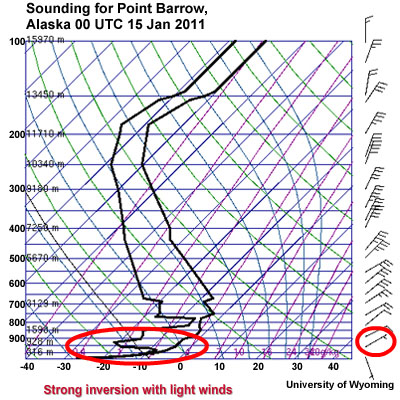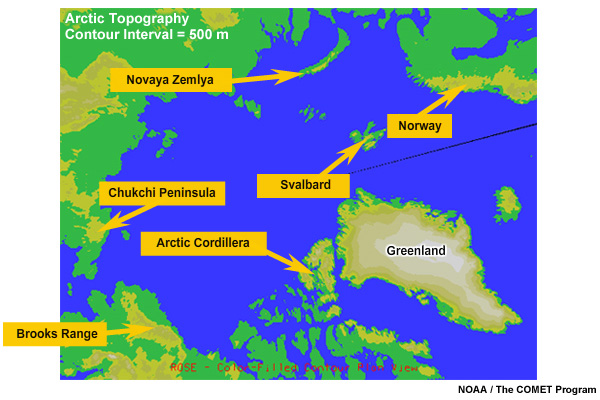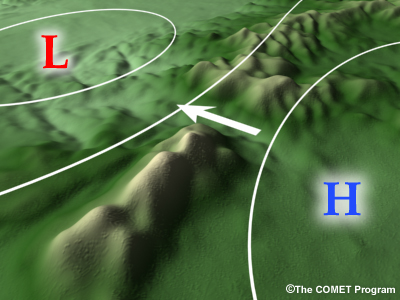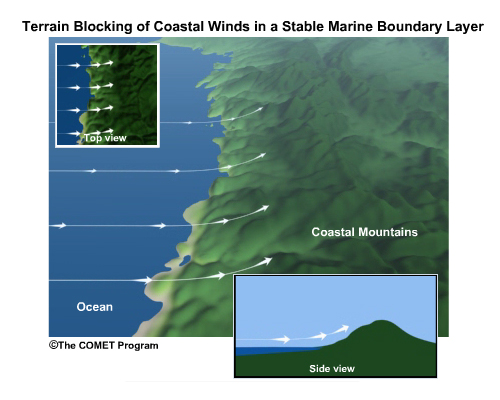Table of Contents
Flow Interaction with Topography
Flow Interaction with TopographyTheoretical Considerations
Whether topography will block and turn wind depends on three factors:
- Stability of the boundary layer
- Height of the terrain, and
- Wind speed.
A stable atmosphere resists vertical motion. The more stable it is, the more likely that air will flow around, rather than over, a topographic obstacle. The taller the obstacle, the less likely it is that wind will pass over it. The higher the wind speed, the more likely it is to overcome the stability and terrain height to pass over the obstacle.
These same considerations apply in the Arctic.
Flow Interaction with TopographyBoundary Layer Stability

The winter Arctic boundary layer is characterized by a strong surface-based inversion. This sounding from Barrow, Alaska, is typical in that it shows a strong inversion with light winds at the surface.
Flow Interaction with TopographyTopography

This map shows Arctic areas over 500 meters elevation in shades of yellow. The edges of these areas are most likely to see topographically influenced winds. The most prominent areas include the Brooks Range, the Arctic Cordillera, Greenland, and Norway. Smaller areas include Svalbard, Novaya Zemlya, and the Chukchi Peninsula.
Flow Interaction with TopographyBarrier Jets
There are two major types of topographically influenced winds that have been documented in the Arctic: barrier jets and gap winds.
Barrier jets occur when a long ridge blocks low-level flow. Unable to pass over the ridge the wind turns parallel to it and accelerates toward low pressure. Barrier jets in the Arctic have been documented along Greenland (Moore and Renfrew, 2005), Baffin Island (Deacu et al., 2010), Norway (Barstad and Grønås, 2005), and the Brooks Range (Kozo, 1984).
Flow Interaction with TopographyGap Winds

Gap winds occur when there is a large pressure differential across a ridge. Wind then accelerates from high to low pressure through gaps in the ridge, sometimes reaching hurricane force near the gap exit. Nares Strait, separating Greenland from Ellesmere Island is notorious for a northerly gap wind (Samelson and Barbour, 2008). Gap winds also occur between isles composing the Svalbard Islands, Canadian Archipelago, and Aleutian Islands.
Flow Interaction with TopographyQuestions
Question 1
Which of the following factors increase the likelihood that wind will be blocked by topography? (Choose all that apply.)
The correct answers are a) "greater stability" and b) "increased height of terrain."
A stable atmosphere resists vertical motions. As boundary layer stability increases, it becomes more likely that wind will be blocked by terrain. Increased terrain height and decreased wind speed also increase the chance that terrain will block the wind.
Question 2
[True/False] The boundary layer in the Arctic is typically very stable.
The correct answer is True.
The boundary layer in the Arctic over the ocean, snow, or ice is characterized by a surface-based inversion.
Question 3
Use the selection boxes to choose the answers that best complete the statements.
The correct answer is that the Aleutian Islands frequently experience gap winds, while the east coast of Greenland frequently experiences a barrier jet.
Flow Interaction with TopographyReferences
To learn more, see the following COMET modules:
- Landfalling Fronts and Cyclones / Conceptual Background:(http://www.meted.ucar.edu/mesoprim/lff/print.htm#2)
- Gap Winds (http://www.meted.ucar.edu/mesoprim/gapwinds/)
- Low-level Coastal Jets (http://www.meted.ucar.edu/mesoprim/coastaljets/)
- Flow Interaction with Topography (http://www.meted.ucar.edu/mesoprim/flowtopo/)
Barstad & Grønås 2005, Southwesterly flows over southern Norway - mesoscale sensitivity to large-scale wind direction and speed, Tellus Vol.57A, 136-152.
Deacu, D., Zadra, A., Hanesiak, J., 2010: Simulating wind channelling over Frobisher Bay and its interaction with downslope winds during the 7-8 November 2006 wind event. Atmosphere-Ocean, 48, 101 – 121.
Kozo TL (1984) Mesoscale wind phenomena along the Alaskan Beaufort Sea coast. In: Barnes PW, Schell DM, Reimnitz E (eds.), The Alaskan Beaufort Sea: Ecosystems and Environment. Academic Press, New York, pp 23-45
Moore, G. W. K., I. A. Renfrew, 2005: Tip Jets and Barrier Winds: A QuikSCAT Climatology of High Wind Speed Events around Greenland. J. Climate, 18, 3713–3725.
Samelson, R. M., P. L. Barbour, 2008: Low-Level Jets, Orographic Effects, and Extreme Events in Nares Strait: A Model-Based Mesoscale Climatology. Mon. Wea. Rev., 136, 4746–4759.
